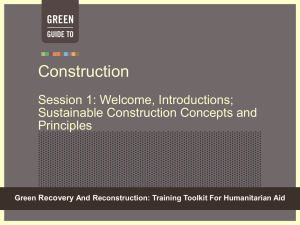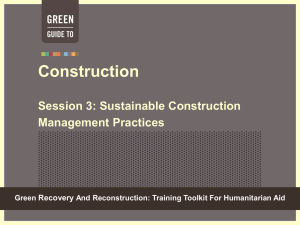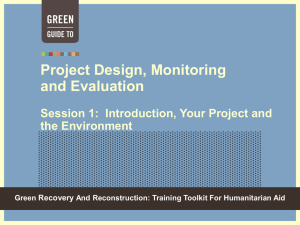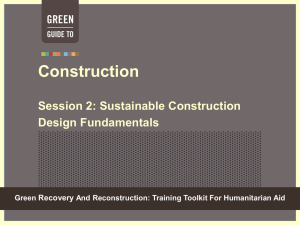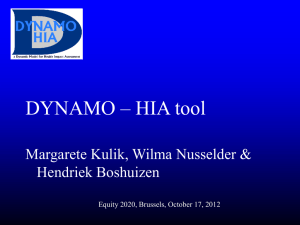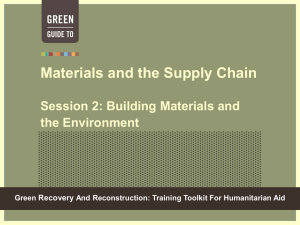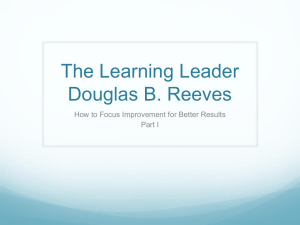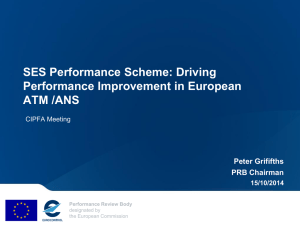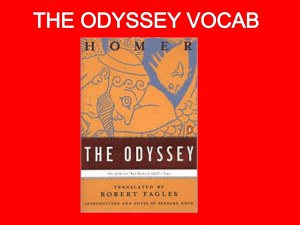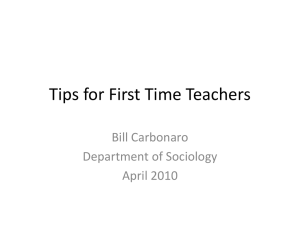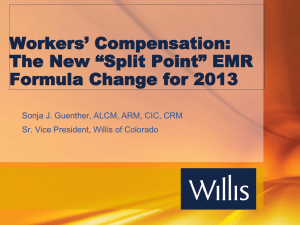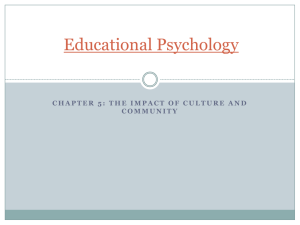Module-7-Session-1 - Green Recovery & Reconstruction
advertisement
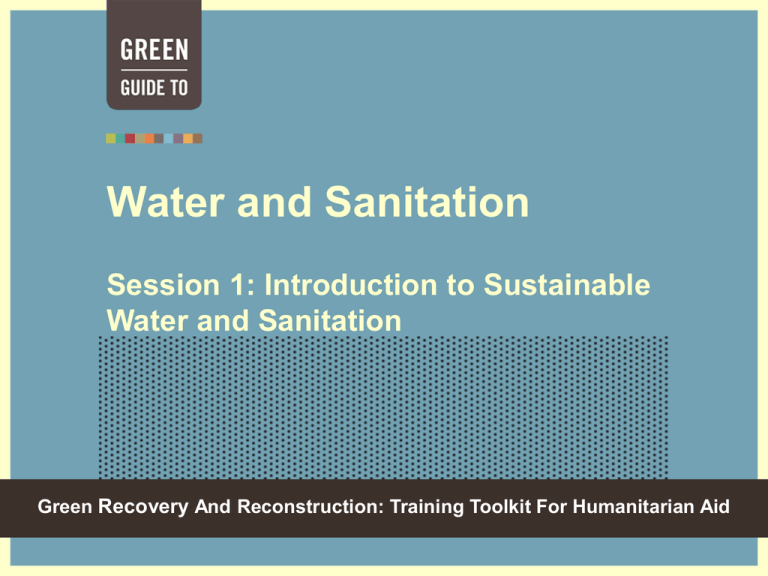
Water and Sanitation Session 1: Introduction to Sustainable Water and Sanitation Green Recovery And Reconstruction: Training Toolkit For Humanitarian Aid Getting to Know You… Please pair-up and ask your partner the following questions: What is your name? What do you do? What type of watsan project have you been involved in? What was one environmental issue you have come across in your program? Mod 7 Ses 1 2 Ground Rules Mobiles silent Be punctual Stay on topic Succinct be brief One conversation at a time Active listening Mod 7 Ses 1 Other? 3 Green Recovery and Reconstruction Toolkit Developed by WWF and the American Red Cross Based on a 5-year partnership formed after the 2004 tsunami between WWF, AmCross and partners in Indonesia, Sri Lanka, Thailand and Maldives Designed for use globally after natural disasters and conflict Mod 7 Ses 1 4 10 Program Modules Green Guide to: 1. Opportunities for Green Recovery and Reconstruction: An Introduction 2. Project Design, Monitoring and Evaluation 3. Environmental Impact Assessment Tools and Techniques 4. Strategic Site Selection and Development 5. Materials and the Supply Chain 6. Construction 7. Water and Sanitation 8. Livelihoods 9. Disaster Risk Reduction 10.Organizational Operations Mod 7 Ses 1 5 GRRT Principles “Do no harm” to people and communities recovering from disaster by addressing environmental sustainability Recognize that addressing the environment has multiple benefits Take ownership Build back safer Be solution-oriented Emphasize the use of local knowledge “Words to live by.” -- Ron Savage, OFDA Mod 7 Ses 1 6 Workshop Agenda 08:30 – 10:20 Registration, Introduction to Sustainable Water and Sanitation 10:20 – 10:50 Break 10:50 – 12:30 Overview of watsan technologies 12:30 – 13:30 Lunch 13:30 – 14:45 Environmentally sustainable technologies, continued 14:45 – 15:00 Break 15:00 – 16:30 Case study analysis 16:30 – 17:10 Evaluation and closing 17:10 Adjourn 7 Environmentally Sustainable Water and Sanitation What do we really mean? 8 Mod 7 Ses 1 9 Mod 7 Ses 1 10 Mod 7 Ses 1 11 Mod 7 Ses 1 12 Mod 7 Ses 1 13 Mod 7 Ses 1 14 Mod 7 Ses 1 15 Mod 7 Ses 1 16 Workshop Objectives Promote and implement water and sanitation systems that improve community well-being through enhancing environmental sustainability. Explain to stakeholders why water supply project infrastructure should include watershed protection. Demonstrate how water and sanitation projects can be made more sustainable for communities through initial technology choice, project design and community consultation. 17 Sustainability: “Development that meets the needs of the present without compromising the ability of future generations to meet their own needs.” Mod 7 Ses 1 18 GOAL: Develop watsan projects that meet the needs of the present without compromising the ability of future generations to meet their own needs. How do we do that? Mod 7 Ses 1 19 External threats can prevent the success of watsan projects 20 Spring Catchment 21 Source spring 22 Catchment dam 23 Downstream pipe 24 Storage and distribution 25 Logging 26 Brick borrow site 27 Agroforestry 28 Recreation Mod 7 Ses 1 29 Mining Mod 7 Ses 1 30 Mining Mod 7 Ses 1 31 New road construction Mod 7 Ses 1 32 Watershed Mod 7 Ses 1 33 “Lack of cross-sectoral linkages leads to uncoordinated water resource development and management resulting in conflict, waste and unsustainable systems.” --UNDP Capacity Building for Integrated Water Resources Management Mod 7 Ses 1 34 Solution: Integrated Water Resources Management Definition: Systematic, participatory process for the sustainable development, allocation and monitoring of water resource use in the context of social, economic and environmental objectives Mod 7 Ses 1 Also known as: Comprehensive Watershed Management Integrated Coastal Area Management Integrated River Basin Management Integrated Catchment Management 35 SPHERE and WHO Context SPHERE Water Supply Standard 2 calls for “promotion of protected sources.” SPHERE Shelter and Settlement Standard 6 key indicator: “natural resources are managed to meet the ongoing needs of displaced and host populations.” WHO Guidelines for Safe Recreational Waters promote “Integrated Coastal Area Management.” Mod 7 Ses 1 36 Integrated Water Resources Management Implementation Framework Mod 7 Ses 1 37 Integrated Sustainable Solid Waste Management Mod 7 Ses 1 38 Mod 7 Ses 1 39 Recycling center Mod 7 Ses 1 40 Mod 7 Ses 1 41 Questions: How would implementing IWRM or ISWM change the way you do your current projects? What would you do differently in the future? What are specific activities to address IWRM/ISWM? 42 Let’s Take a Break. InterWorks photo 43
